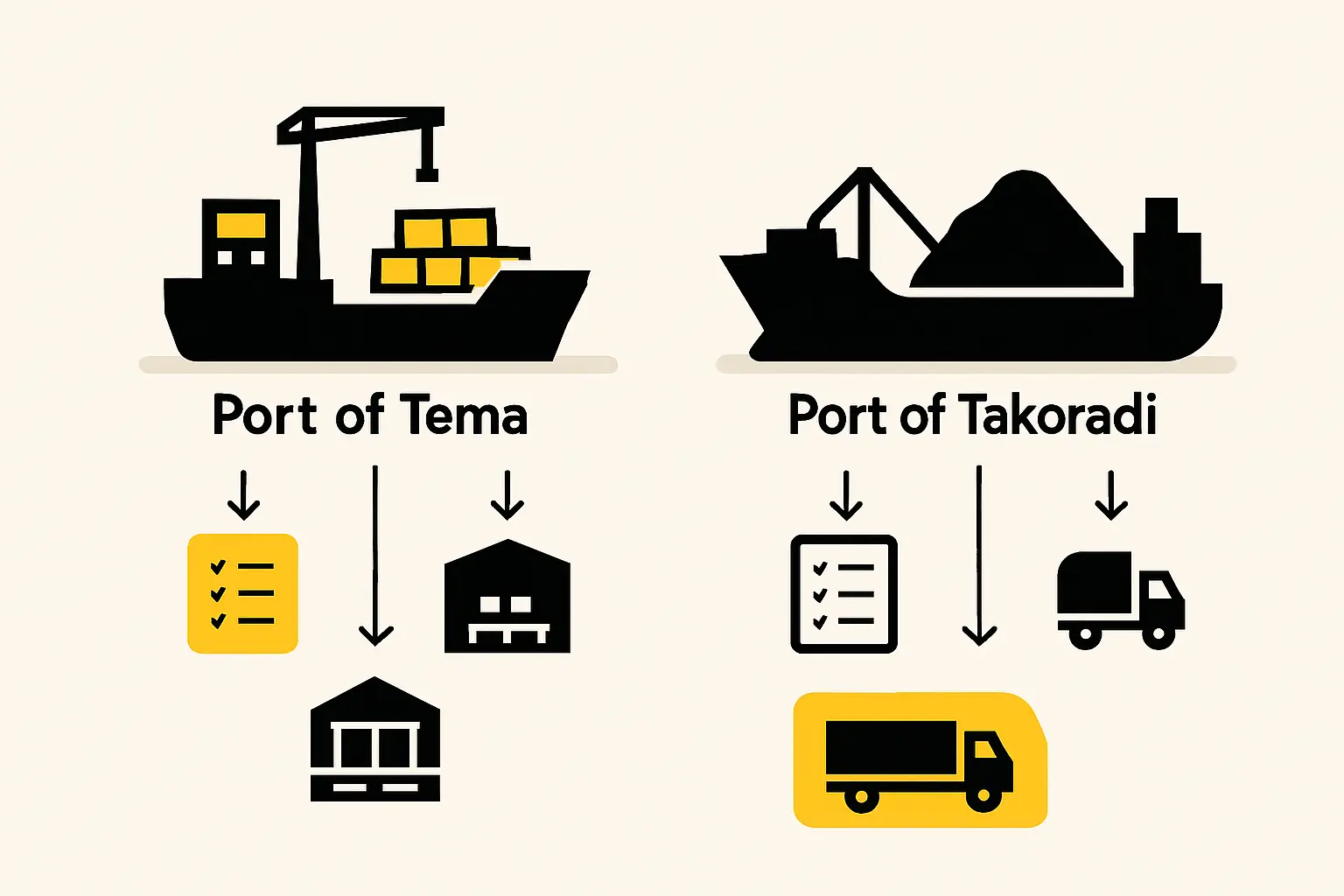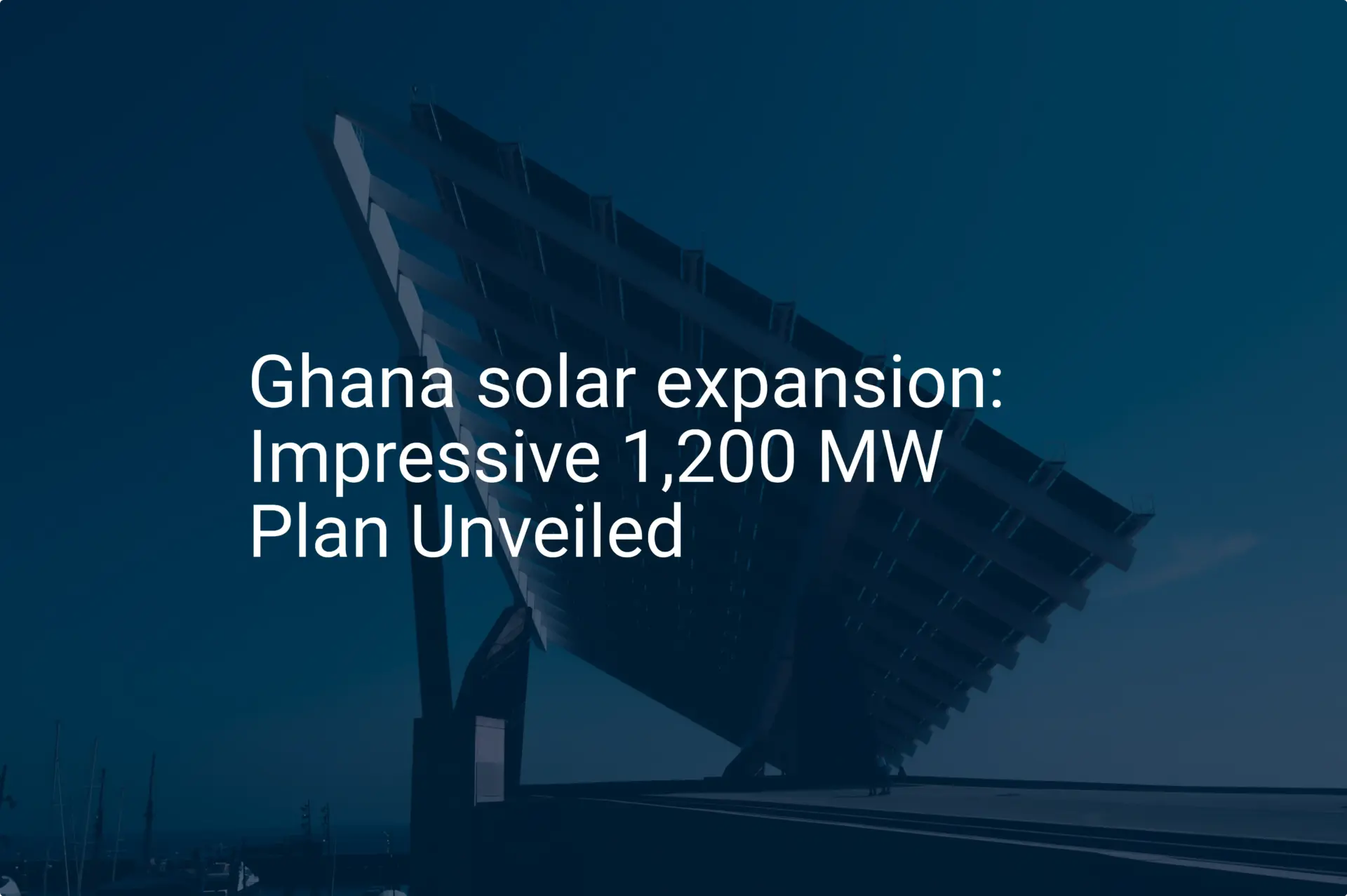An entrepreneur can develop a robust business plan, secure financing, and design a state-of-the-art solar module factory. Yet, the entire project’s success can hinge on a factor often considered too late: the efficiency of the port chosen for importing raw materials.
A container of delicate solar cells or a shipment of specialized glass sitting for weeks in a congested port can derail production schedules and inflate budgets before the first module is even assembled.
This article compares Ghana’s two primary maritime gateways—the Port of Tema and the Port of Takoradi—focusing on critical factors for an aspiring solar manufacturer: customs clearance, inland transport connectivity, and storage facilities to help investors make a more informed logistical decision.
The Critical Role of Port Selection in Solar Manufacturing
Choosing a port is more than a geographical decision; it is a strategic one that directly impacts a project’s financial and operational viability. A port’s efficiency is a major factor in project timelines and costs, as delays in clearing essential materials like EVA films, solar glass, and photovoltaic cells can halt a production line and lead to significant financial losses.
These materials also require specific handling. Solar glass is fragile and heavy, while cells and encapsulants are sensitive to environmental conditions. A port’s handling and storage capabilities are therefore paramount, as a misstep in logistics can compromise material quality, leading to lower production yields and reduced module performance.
A Profile of Ghana’s Key Maritime Gateways
Ghana’s coastline is served by two major ports, each with distinct characteristics, strategic locations, and operational strengths. Understanding their profiles is the first step in aligning a factory’s supply chain with the right logistical hub.
The Port of Tema: The Eastern Hub
Located just 25 kilometers east of the capital, Accra, the Port of Tema is the largest and busiest port in Ghana. It handles approximately 85% of the nation’s container traffic, positioning it as the country’s primary commercial gateway. Major recent investments, particularly the development of Meridian Port Services (MPS) Terminal 3, have significantly increased its capacity and efficiency, equipping it with modern infrastructure capable of handling the world’s largest container vessels.

Its proximity to Accra and the Tema Free Zones Enclave makes it a strategic choice for industries targeting the country’s main economic centers and export processing zones.
The Port of Takoradi: The Western Hub
The Port of Takoradi, situated in Ghana’s Western Region, has traditionally been the country’s leading port for exporting bulk commodities such as manganese, bauxite, and cocoa. In recent years, it has become a major logistical hub for the burgeoning oil and gas industry. While its container traffic is lower than Tema’s, the port is undergoing significant modernization to diversify its cargo-handling capabilities and improve efficiency.

Its strategic location serves the western corridor of Ghana and provides a potential gateway to landlocked neighboring countries like Burkina Faso and Mali.
Comparative Analysis for Solar Component Imports
For an entrepreneur planning to import solar manufacturing components, the choice between Tema and Takoradi depends on a careful evaluation of several operational factors.
Customs Clearance and Bureaucracy
A smooth customs process is essential for maintaining a lean supply chain.
-
Tema: The port’s Paperless Port System aims to streamline clearance processes and reduce paperwork. However, the sheer volume of cargo passing through Tema can still lead to congestion at inspection points. While efficient in theory, peak periods can challenge timelines.
-
Takoradi: Due to its lower container volume, Takoradi may offer faster and more personalized service. For specialized or non-standard cargo, the port’s administration might provide more flexible and quicker clearance times—a significant advantage for time-sensitive projects.
Inland Transportation and Connectivity
The cost and reliability of transporting materials from the port to the factory are critical budgetary considerations.
-
Tema: Connected to Accra and the eastern industrial corridor via a well-maintained motorway, the port provides excellent and reliable access to the country’s largest consumer market and manufacturing base. For a factory located in or near the Greater Accra or Eastern regions, Tema is the logical choice.
-
Takoradi: Takoradi’s road network effectively serves the Western, Central, and Ashanti regions. However, road connectivity to the eastern part of the country is less direct compared to Tema. Ongoing railway modernization projects aim to improve this, but for now, road transport remains the primary method.
The location of the port relative to the final factory site is a key consideration, influencing both cost and the overall project timeline. This choice is a key part of the initial solar factory building requirements.
Storage and Handling Facilities
Solar components have unique storage needs that not all facilities can accommodate.
-
Tema: As a major container hub, Tema offers extensive modern warehousing and container storage facilities. Its infrastructure is well-suited for standard 20ft and 40ft containers, which are typically used for shipping solar cells, junction boxes, and aluminum frames.
-
Takoradi: While equipped with excellent facilities for the oil and gas sector, its general container and warehousing capacity is less extensive than Tema’s. Entrepreneurs should verify if the available facilities can meet the specific climate-controlled conditions required for materials like EVA film.

Making the Strategic Decision: A Framework for Entrepreneurs
The optimal port isn’t the same for every project; the decision demands a project-specific analysis. Experience from J.v.G. turnkey projects shows that a detailed logistical plan is a non-negotiable part of a successful feasibility study.
Consider the following questions:
-
Factory Location: Is the planned factory in the eastern corridor (near Accra/Tema) or the western corridor (near Takoradi/Sekondi)? Proximity is the most significant factor for reducing inland transport costs and delays.
-
Import Volume and Frequency: A large-scale operation with continuous, high-volume imports may benefit from Tema’s capacity and shipping line frequency. A smaller or pilot-phase factory might find Takoradi’s less congested environment more manageable.
-
Timeline Sensitivity: If production schedules are extremely tight, the potentially faster clearance times at Takoradi could be a decisive advantage.
-
Supply Chain Complexity: Will you require specialized storage or handling? Engage with both port authorities and local logistics partners to confirm that the necessary facilities are available.
This logistical analysis directly impacts both the operational expenditure and the initial investment for a solar panel plant.
Frequently Asked Questions (FAQ)
What are the typical lead times for customs clearance in Ghana?
While this can vary, the goal of the paperless system is to reduce clearance times to under 48 hours. In practice, entrepreneurs should budget for 3-7 business days, accounting for potential inspections and administrative steps. Delays can occur, so building a buffer into the project timeline is recommended.
Are there free trade zones near these ports?
Yes. The Tema Export Processing Zone is a major industrial park offering significant tax and customs incentives for manufacturing companies. Its proximity to the Port of Tema is a key advantage for export-oriented businesses. The Sekondi Free Zone offers similar opportunities for businesses using the Port of Takoradi.
How are port charges generally calculated in Ghana?
Port charges are typically based on a combination of factors, including the container size (measured in twenty-foot equivalent units, or TEUs), cargo weight, vessel fees, and the duration of storage (demurrage). The Ghana Shippers’ Authority (GSA) provides oversight and information on applicable charges.
Is it necessary to use a local clearing agent?
Yes, it is highly recommended. A licensed local clearing and forwarding agent has the expertise to navigate customs procedures, documentation requirements, and local bureaucracy efficiently. Their services are invaluable for preventing costly delays and ensuring compliance.
Conclusion and Next Steps
The selection of a port of entry is a foundational decision in establishing a solar module manufacturing plant in Ghana. The Port of Tema offers unmatched capacity, modern facilities, and superior connectivity to the country’s economic heartland. In contrast, the Port of Takoradi presents a compelling alternative with the potential for faster clearance times and a strategic position serving the nation’s western regions.
The right choice is not about which port is “better” in absolute terms, but which is strategically aligned with your factory’s location, scale, and operational model. A thorough understanding of these logistical factors is an essential step in developing a comprehensive and realistic business plan for any solar manufacturing venture.





